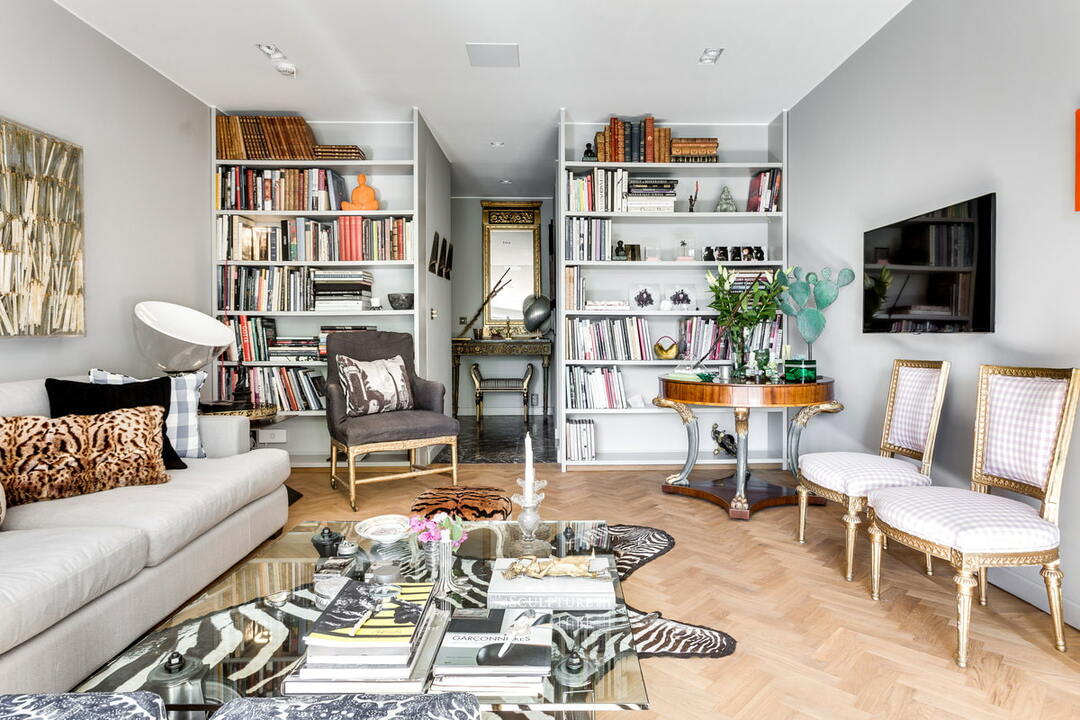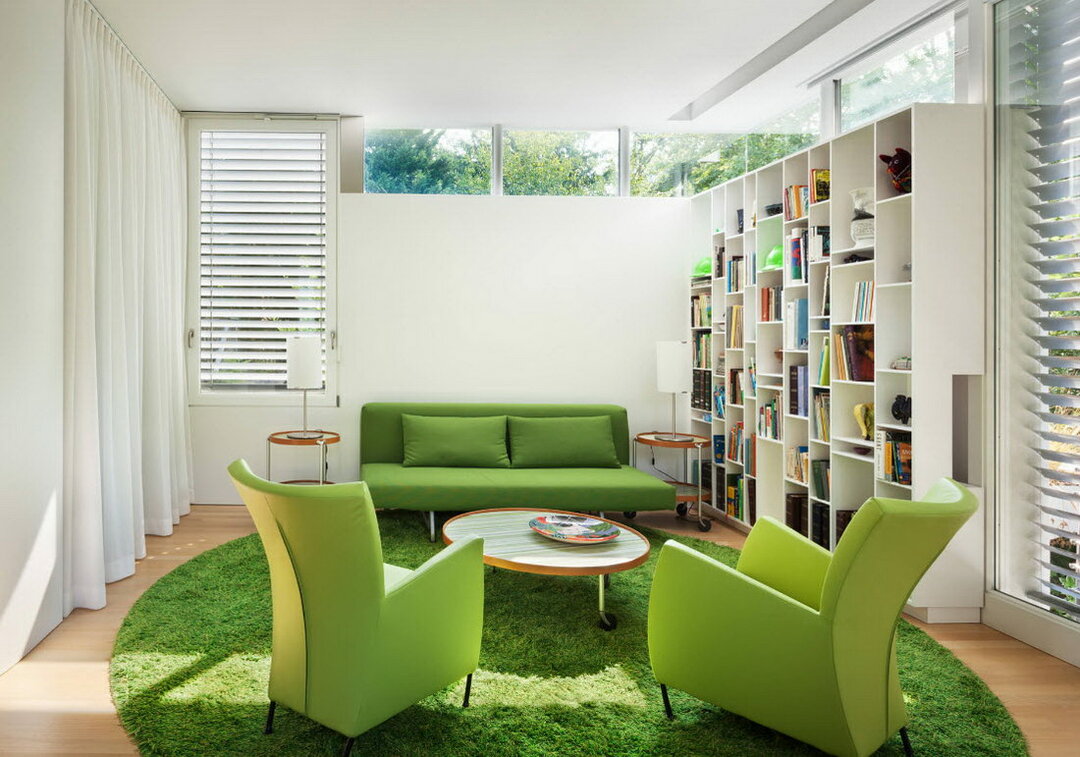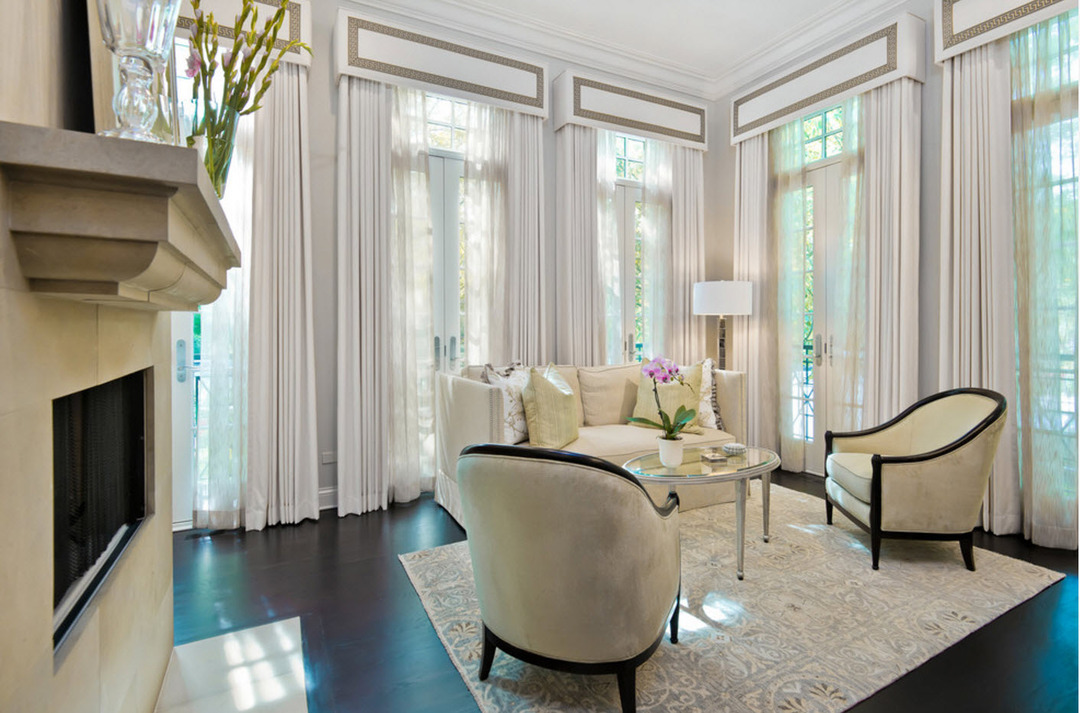An interesting material for interior surfaces hardly a full-fledged wallpaper. This kind of paper rather refers to the plaster. The dry multicomponent mixture was diluted with water in the right proportions and applied to a wall. Magazinny powder may be based on cellulose fibers, cotton, sawdust, paper and other materials. Available ingredients easily combined into home and cook liquid wall with their hands no worse issued under the famous brand name.
Content
- Advantages and disadvantages
- Preparation of the composition of the finished store
-
Cooking your composition
- the necessary equipment
- What to use as a binder base
- A variety of decorative additives
- The basis of the paper
- The basis of the fabric fibers
- Basis of sawdust
- The choice of dye
-
Rules and advice applying liquid wallpaper
- Preparing walls
- application technique
- Application of the protective coating
- As applied patterns liquid wallpaper
- Tips for taking care coverage
- conclusion
Advantages and disadvantages
The decoration of the walls liquid wallpaper is easy to do yourself. With manufacturing and material to its application to handle even far from the repair man. The main advantage of the finishing mixture - the ability to pass air, which is especially important in the decoration of the walls in private homes and apartments on the 1st floor. Simple finishing technology allows work without the involvement of specialists. After applying a layer of a monolithic surface is created without seams, which significantly reduces wear. For other advantages of liquid wallpaper include the following factors:
- Security constituent substances to humans and animals;
- Hypoallergenic, antistatic;
- Ability to create a unique interior;
- Direct exposure to sunlight does not lead to changes in color and texture;
- Good masking minor surface imperfections;
- Unfavorable environment for the development of mold and mildew;
- Ability compatibility with other types of finishes (painting, wallpaper pasting roll standard);
- Remains dry mixture can be permanently stored in a dry room.





A significant drawback of liquid wallpaper - the high price. Compared with roller blades marked a small selection of colors and patterns. Problem can be solved by selection of suitable pigments. This material is suitable for decoration of bedrooms and nurseries.

In rooms with high contamination likely to use it irrationally, because liquid wallpaper is not designed for washing. Have cut portion stain and cause a new mixture. The disadvantages of the material can also include the need for prolonged drying.





Preparation of the composition of the finished store
Factory mixture was visually resembles a dry sawdust is discharged in different shades and textures. It is packed in plastic bags with a tight clasp. The composition of the material already contains all necessary substances for the creation of a durable decorative layer as a wallpaper. The finished material has some advantages - do not have to worry about the quality of finishes in self-mixing of the ingredients. Can be in the store to choose the color of the substance, grain, brightness, intensity, brilliance.
it is necessary to calculate before purchasing the required volume of the mixture. Doing this, it is desirable with a small margin. Cooking material better in small portions, so that it had the opportunity to thoroughly be stirred. The prepared plastic bucket pour and fill dry cells of warm water in proportions specified on the packaging. The material should be thick enough not to drain from the spatula upside down.
Then the future wallpaper shift in the package, tied and left 12 hours to infuse. After this time, you can start decorating. Diluted ready mixture can be hermetically sealed in plastic bags to 2 weeks.
In the calculation should take into account the type of material of the walls. From the base material consumption depends on the wallpaper and the complexity of the application. Many types of surfaces require priming, protection against dark spots alignment.

Cooking your composition
High consumption of the bulk material for the preparation of the wallpaper, the high cost of its push to independent manufacturing. Homemade mixture, in addition to significant savings, will create a unique interior, turn a boring repair an exciting creative activity. To produce liquid wallpaper in the home should be strictly on prescription. From compliance proportions and other conditions will depend on the strength, elasticity, decorative material. With self-manufacturing, you can choose a suitable basis to a particular case, a binder base, decorative additives.
See also:White wallpapers in the interior

the necessary equipment
First we need to prepare the main constituent components. The most affordable option - paper. Using sheets of any density (pages of old books, fragments of albums, newspapers). Also popular base of the fabric fibers, sawdust, wool yarn, wool. Per kilogram of dry substance required 6 liters of water. To make at home a liquid mixture of wholemeal, you need the following materials and tools:
- Components for tinting;
- Binder (Alabaster, gypsum);
- Wallpaper glue;
- Primer, acrylic lacquer;
- Elements to impart decorativeness (spangles, sliced tinsel, bronze, silver powder);
- Drill with a special nozzle for uniform mixing;
- Plastic bucket 12 liters, the tray;
- Several spatulas of various sizes;
- Transparent trowel.






What to use as a binder base
The best binder - PVA glue. As well as Bustilat, it has an affordable price, it is a durable, high-quality product. Among the shortcomings can be noted a long drying. To improve the adhesion of suitable wallpaper casein glue. The composition includes a mixture of a natural protein derived from cow's milk. Cons - poor resistance to moisture, a small shelf life of the diluted composition. Use a liquid adhesive on the basis thereof need for 4 hours.
The most resistant material for the walls and ceiling create an acrylic filler. The lack of such a connection base - a sharp, unpleasant odor, which is difficult to get rid of, even in a ventilated area.

A variety of decorative additives
To solve important technical, decorative tasks in liquid wallpaper add special components. When choosing suitable options should be guided by the similarity of the structure, only use high-quality items that are not subject to oxidation, mold and fungus. Decorative additives introduced into the prepared mass after ripening in the package.
In use as a color additive, water-dispersed pigments. Mortar define the overall tone. Evolved inclusions obtained by solidified ink particles, chopped colored thread. To protect the natural fibers from rotting apply fungicides. Impermeable coating is created by adding flame retardants. For rapid solidification added plasticizers or other thickeners.
Using additives it is possible to vary the thickness of the coating which is wallpaper. Make dense layer polymer beads, minerals aggregated grains. The mixture with small inclusions can be used to create a translucent liquid substance 1 mm thick.
To make the coating as much as possible similar to canvas fabric, in the liquid wallpaper added textile yarns. Material intertwined with fine mixing and reinforces weight during solidification. Filamentous inclusions are also a good addition to a variety of texture and color of the mixture. Interesting overflow will give gold, silver glitter metallized powder, grains of mica, cut lurex.

The basis of the paper
In the manufacture of liquid wallpaper of the paper it is important to adhere to the principle - the high quality raw materials, the better the result. Ideal - white plain paper without any text and print. If you have only used the sheets, it is necessary to take into account that the mixture can be tinted poseret bad. The following step by step master class will teach to prepare a decorative finishing material in the simplest way:
- Put the chopped paper, egg trays in a plastic bucket and fill it with warm water;
- Raw reserve for several hours until complete disintegration;
3. Adding bleach and wait for another 30 minutes; - Wash bleached mass under running water, filtered and shred construction mixer until a slurry state;
- Adding the colorant, binders (100 ml per 1 kg of adhesive paper), thickeners;
- Bring to desired consistency. If the mass of highly liquid, set aside for a time, to evaporate excess moisture. In highly dense wallpaper add water;
- We put in the bag and sealed. After 2 hours, a fine additive.





The basis of the fabric fibers
To prepare the mixtures based finishing textile fibers used crushed portion flax, silk, cotton, wool, padding polyester, polyester. The recipe will vary depending on the volume weight materials and their length particles. Preparation of the working mass must begin with the selection of the best combination of components by decreasing, increasing one of them.
See also:Mural in the interior - 50 examples
Manufacturing technology is a simple turn-based action. First textiles maximum ground by hand, add pigments, plasticizers, and other necessary components. The smaller pieces of material, the smoother the slurry will lie on the surface. Plaster and gypsum in this case do not use.
Before you put the mixture on the maturation, it is necessary to test on a small area of the wall or ceiling. Material behind walls - much moisture, the composition shelled - few binders, surface cracks - the lack of a mineral filler.

Basis of sawdust
Form an interesting relief structure will help ordinary sawdust. Pleasant to the touch finish is very easy to glue. Waste after sawing wood materials provide wall, ceiling coverings excellent heat and sound insulation. Liquid wallpaper on the sawdust is well pass the air, not covered with mold. The widespread availability of composite component enables to experiment with the basic composition, independently adjust the proportion of ingredients for different rooms.
To properly prepare the composition for decorative require 1 kg of sawdust, 500 ml of glue, water, colorants, optional additives and antiseptic composition. First, a small wood chips by sieving through a sieve with a large mesh. All pour into the vessel, and added pigment covered with water. Liquid wallpaper is necessary to mix well by hand or with a mixer. Add glue and leave for a full 8 hours of impregnation.
Before the application to add surface alabaster. Bring to a putty consistency. We have to work as quickly as possible, given the speed of solidification of the adhesive mass.

The choice of dye
The easiest way to achieve the desired result, if the pigment is added to the pure white color base mixture. In this case, you can get absolutely any color. In order not to put all the work for nothing, it is necessary to choose a color for liquid mixtures and adding it together with water.
The concentrated pigment may be organic-based and synthetic. In the first case, the surface is less resistant to UV light, but has a great diversity of shades. The product has a pasty or liquid consistency. Suitable colorants, intended for water-dilutable paint formulations.
Change Color liquid mixture at any time prior to application. Time correction - 3 hours after preparation. After the shade will be distorted. It should be understood that the colored mass in the bucket will appear a few shades brighter than on the wall. To the introduction of the pigment in the liquid wallpaper has passed without any problems, we should heed the following recommendations:
- It is necessary to accurately observe the mixing ratio indicated on the packaging manufacturer;
- Dissolve color necessary in water intended for kneading the mixture;
- The milled material must be in the dye is not less than 2 hours;
- Achieve the same tone can only mixing directly the entire volume. If this is not possible, it is necessary to accurately count, memorize proportions.

Rules and advice applying liquid wallpaper
Finishing material based on paper, textiles, sawdust can be used in any room. Kitchen and bathroom need additional protection coatings in the form of special lacquers and enamels. The end result has exceeded all expectations, you must follow exactly the application technology of liquid wallpaper. Repairs begin with surface preparation, mixing the adhesive mass as finishing shelf materials must pass accurately and as quickly as possible.

Preparing walls
Any manipulation of the vertical, horizontal surfaces require their careful preparation. For interior use formulations suitable for the particular wall material. Most use a single primer. It retains all the properties and characteristics of liquid wallpaper for a long time. Technology of surface preparation is selected depending on the features overlap age. The careful alignment of the walls do not need. Universal solutions and liquid starter interact differently with the following basis:
- Plasterboard. Treat the entire surface in several layers since the joints place will absorb more moisture;
- Paint. Old, obluschivayuschiysya material should be removed and the remains of paste to fix it on the wall. After which the surface can be primed;
- Whitewash. Mel necessarily need to remove from the walls and ceiling, as it will prevent the adhesion of liquid wallpaper with the surface;
- Chipboard. Impose third or more layers of primer. This will help to make a uniform moisture absorption;
- Wood. Because of the special structure of the array and the uneven moisture absorption material dyed ground several times;
- Concrete. The primer is applied to the concrete surface in order to isolate from the wet environment liquid wallpaper;
- Plywood. For the wall and ceiling make better use of sheets of maximum thickness, but primed they still need at least 3 times.
See also:Walls - 30 ideas with their own hands

application technique
Flatten and move the liquid wall on the surface by using a spatula, trowel, plastic or metallic trowel. Also need a spray bottle to moisten and smooth the dried up areas.
The process of applying the mass on the wall is very simple. You need to bring a tool to scoop up material and transfer the sodden surface. You can also do hands and then well smooth trowel. I should get a layer thickness of 1-3 mm.
During the works, it is not necessary to press the trowel too hard against the wall. Move it should be vertically or horizontally. When the entire wall will be processed, it is necessary to moisten a grater with water and make the surface smooth as possible.

Application of the protective coating
The correct choice of coating materials as a finish coating depends on the duration of the service finishes, decorative, way to decontamination. Nitrovarnishes should be deleted immediately, as solvents spoil the base paper or sawdust completely.
The best option for liquid wallpaper - acrylic paint. A solution of a water-based neutral dyes to completely discolored. It is applied to the surface pasted with a brush, roller or by spray. After drying, the protective layer becomes inconspicuous and finishing looks the most natural.
Liquid wallpaper lacquered become resistant to mechanical damage. Colors stay bright for a long time. The surface becomes water-resistant qualities, it is possible to clean it with cleaning fluids.

As applied patterns liquid wallpaper
Finished liquid wallpaper does not happen at once with a picture. Create simple or complex composition of lines have their own, relying on his imagination or prepared template. The techniques of random and applying the template are different from each other.





The application screen printed pattern must consist of two stages. First the base layer is leveled wallpaper. After it is completely dry attach the stencil to the masking tape and spread pattern.

Creation of author's figures more complex process. Hours increases a large amount of used textures and colors. On the wall is applied to the prepared outline patterns or pictures in pencil. Mark each section used and color. Then prepare the wallpaper right colors and applied one by one, trying to avoid contact of the wet colored substance.





Tips for taking care coverage
The easiest way to remove dirt with a vacuum cleaner. Just walk on the surface with a soft nozzle. Delicate texture wallpaper does not tolerate friction, excessive overlap, other mechanical influences. If finishing varnished, remove dust and smudges can be wet cloth with a liquid detergent.

For stains on the unpainted wall, you can try to get rid of them ordinary clerical float. If you notice rust, it is important to quickly find a place of contact with the metal, remove old wallpaper, to handle special tools wall, apply a new slurry. To change were as invisible, it is necessary initially to have a free-flowing paper plaster and pigment left.





conclusion
To independently produce and apply liquid wallpaper on the surface can absolutely anyone. Walls and ceilings require a minimum of training. Original finish is safe and aesthetically pleasing. For the realization of an idea it does not take a lot of time, effort and cost.



